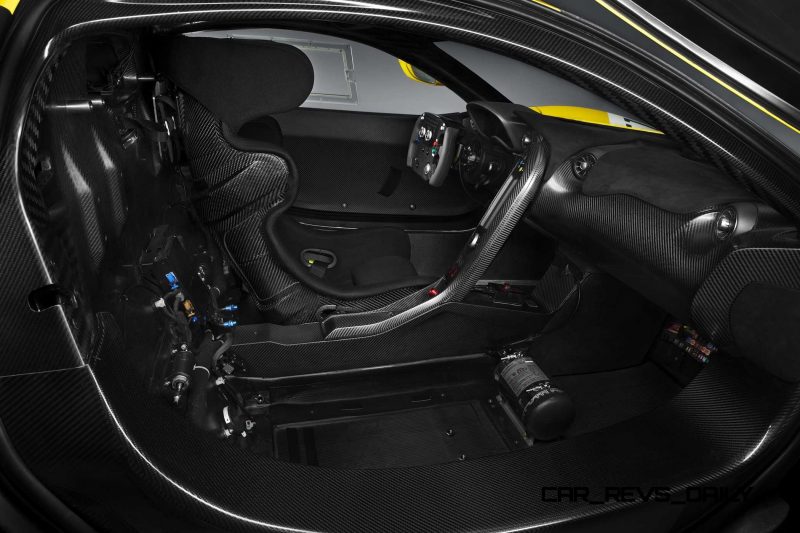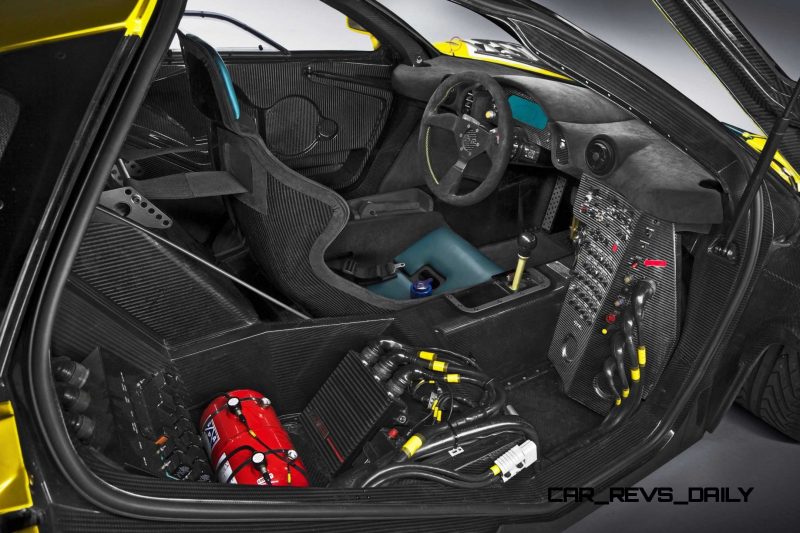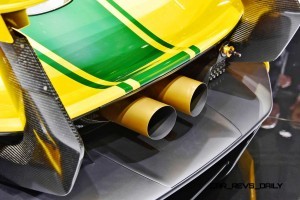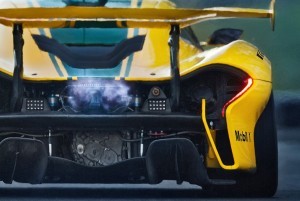Updated 3.3.15
Seeing the 1997 F1 GT LongTail at the Geneva show really drives home how different it is than the original road car. A dramatically-flared rear fender and lower aero upgrade beside the doors is a big part of the upgrade, along with a giant front splitter and pointy rear end.
1997 McLaren F1 GT LongTail
The 2016 McLaren P1 GTR is now in full racing mode.
Scary-fast and ready to blast out of the pits at the Circuit de Catalunya later this year with the elite crop of owner-drivers who will join the ultimate racing experience.
The P1 GTR is significantly stripped and optimized for track duties versus its P1 road-going hypercar base-point, which was no shrinking violet itself when it comes to extreme performance.
The P1 GTR is an in-house way for McLaren to bring its racing expertise to regular owners, with full pit-crew support and the chance to touch the P1 GTR’s high limits in a relatively controlled and safe environment. While the car is not street-legal for major markets like the US and EU, it will be able to slip through the regulations of less-strict places like the Middle East and the Far East.
Overall, McLaren is coy about quoting actual performance stats for the P1 GTR so far, as most of the changes have been taken to improve overall lap times versus just basic sprints or Vmax runs.
Even so, we are looking at an extra 200 horsepower from the engine and electric motor units, a drop of an estimated 300-pounds in curb weight via removal of the stereo, airbags, sound deadening material, side glass in favor of polycarbonate, and numerous other upgrades.
As such, we predict conservatively that the P1 GTR will hit 60-mph in just a flash: 2.2-seconds or less. Overall top speed is highly affected by the aero package and gear-set, which are again optimized to wipe your face off around tracks between 20 and 200-mph. Even so, with the adjustable-wing still operational — we could be staring at the bright-yellow face of a future 240-mph-plus P1 GTR right here.
That’s right: faster than the catless racer McLaren F1’s record-breaking 240-mph run is theoretically possible in a customized P1 GTR some time in the future.

For now, the style of the wide-track P1 GTR is now even more stunning than the Pebble Beach concept. Extra spats and spoilers up front, a fresh nose clip with less bluntness in its surfacing to channel more air to the radiators, and the Iconel exhaust pipes large enough to stick you arm in up to the shoulder.
We like that the new nose is body-colored now versus a contrast carbon-fiber grey, and we also are thrilled to hear that the giant wing is not fixed — it still maintains its ability to jam upwards to be an air brake, as well as modulate downforce as needed at all times.
Very exciting stuff from McLaren. If you own a P1 and are now ruined in terms of what a fast car feels like, the P1 GTR is the perfect way to recharge your brain with sensory overload. Think of the P1 GTR as a ram-air system for your adrenal glands.
The price?
Your soul!
Just kidding. It is actually a very-reasonable $2-million. =]
2016 McLaren P1 GTR
Yellow
Geneva 2015 Livery
McLAREN P1™ GTR TO SHOW ITS LIMITED PRODUCTION FORM IN GENEVA
- Makes the transition from concept to production with track tested modifications
- Tuning in development results in 10 percent more downforce than the McLaren P1™ road car
- Lightweight components and motorsport technologies trim a further 50kg
- McLaren P1™ GTR Driver Programme confirms first locations
- Geneva Show car livery inspired by iconic McLaren F1 GTR, chassis #06R
- McLaren P1™ GTR will premiere alongside the recently announced McLaren 675LT on Stand 1240, Hall 1 at 12.15 CET (11.15 GMT) on Tuesday, 3 March
The track-dedicated 1000PS McLaren P1™ GTR will debut at the 85th International Geneva Motor Show in limited production form with only minor modifications to the Design Concept presented just six months ago. The most noticeable change is the livery that the Geneva show car will be sporting. It is one which will be available to the fortunate few who will be joining the McLaren P1™ GTR Driver Programme that kicks off at the Circuit de Catalunya in Spain later this year. The design is homage to the yellow and green McLaren F1 GTR, chassis #06R, which has claimed its own place in history as one of the five F1 GTRs that dominated the 24 Hours of Le Mans in the historic debut by McLaren 20 years ago.
From design concept to the track
The McLaren P1™ GTR has completed an extensive and intense testing schedule across the world following the unveil of the Design Concept at the Pebble Beach Concours d’Elegance last summer. This has produced enhancements to the original design to optimise aerodynamic performance and cooling.
The front track is 80mm wider than the road-going McLaren P1™ and with its aggressively profiled front splitter, the also car sits 50mm lower to the ground on centre-locking 19-inch motorsport alloy wheels shod with Pirelli slick tyres. The lower bodywork is trimmed with a sleek aerodynamic blade as previewed on the design concept, which cleans the flow of air along the car’s flanks.
The lightweight windscreen from the McLaren P1™ road car, measuring just 3.2mm thick, has been retained, while the side windows are now motorsport-specification polycarbonate with a sliding ‘ticket window’ on the driver’s side. The chemically toughened glass panels in the roof have been replaced with carbon fibre panels to give the cabin a more enclosed, cocooned environment, as has the engine bay cover. The weight saving measures on the McLaren P1™ GTR combine to strip out 50kg over the road-going model.
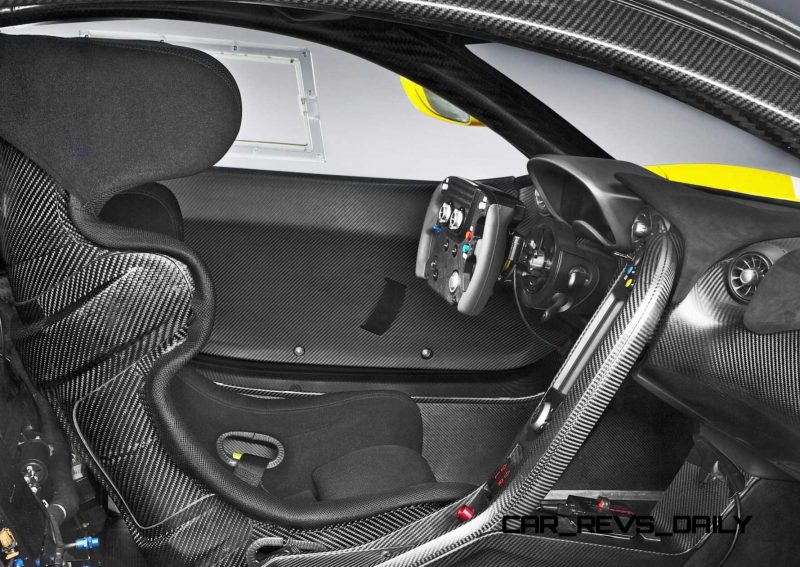



The rear of the track-only model is dominated, in contrast to the road-going McLaren P1™, by the presence of a fixed-height wing which sits more than 400mm above the sculpted rear bodywork – an increase of over 100mm of the adjustable wing on the road car. Working in conjunction with the front-mounted aerodynamic flaps ahead of the front wheels, the rear wing helps to increase downforce levels by more than 10 percent – meaning up to 660kg at 150 mph. Mounted on light weight carbon fibre pylon supports, the wing retains the DRS (Drag Reduction System) of the road car, which trims the pitch from 32° to 0° at the push of the button on the steering wheel. Another bold and differentiating feature at the rear are the large twin exhaust pipes, formed from an Inconel and titanium alloy. This system saves in excess of 6.5kg over the already light road-going system.
Significant updates and modifications to the IPAS powertrain have been made beneath the ‘shrinkwrapped’ carbon fibre bodywork. At its heart, the McLaren P1™ GTR seamlessly integrates the 3.8-litre twin-turbo V8 petrol engine with an enhanced lightweight electric motor. Combined, these powerplants generate 1,000PS; 800PS (789bhp) is produced by the petrol engine, coupled to 200PS (197bhp) available immediately from the electric motor.
The powertrain has been thoroughly revised for optimum performance on track, with key components replaced with motorsport-developed parts, more suited to the sustained high speed running the cars will be subjected to. In addition to this, features within the powertrain of the McLaren P1™ designed specifically for public highway use have been removed to reduce weight.







McLaren F1 GTR #06R: inspiring a new generation
McLaren F1 GTR chassis #06R was campaigned successfully throughout the 1995 and 1996 seasons with Mach One Racing, and is one of the longest serving examples of the McLaren F1 GTR in competition. The Harrods-sponsored #51 was famously one of seven McLaren F1 GTRs to compete at the 24 Hours of Le Mans in 1995, and was driven to the final podium position by multiple Le Mans race winner Derek Bell, his son Justin, and Andy Wallace. After this result, the team went on to win the final three races of the BPR Championship.
The following year, the team enjoyed another strong campaign. Oliver Grouillard joined Derek Bell and Andy Wallace in the line-up for the 24 Hours of Le Mans, and finished a commendable sixth. The team also claimed a win at Silverstone in the Global GT Endurance championship.
McLaren P1™ Driver Programme
The first locations for the first McLaren P1™ Driver Programme have now been confirmed, and will see drivers attend an initial test session at Silverstone, England, followed by the first on-track activity at Circuit de Catalunya in Spain. These events will follow on from individual driver profiling sessions at the McLaren Technology Centre. These tailored consultations will include a race seat fitting, a Human Performance Centre assessment, and final discussions around the design and livery of each model with McLaren Automotive Design Director Frank Stephenson. Each driver will also experience the McLaren P1™ GTR from the simulator for the first time.
Ultimate Series forms the third and final tier of the McLaren model line-up
The McLaren P1™ GTR joins the road-going McLaren P1™ in the Ultimate Series. This exclusive range prioritises aerodynamics and outright performance through notable advances in weight reduction, chassis and powertrain engineering and the use of pioneering materials.
McLaren has now established a three tier naming structure of Sports Series, Super Series and Ultimate Series. The Sports Series is the entry point to McLaren and will make its global debut at the 2015 New York International Auto Show in April. Above this sits the core McLaren Super Series, comprising the 650S, the Asia-only 625C and the recently-announced 675LT which will premiere at the Geneva Motor Show.
The McLaren P1™ GTR will make its global debut alongside the recently announced McLaren 675LT on Stand 1240, Hall 1 at 12.15 CET (11.15 GMT) on Tuesday, 3 March 2015 at the 85th International Geneva Motor Show.



Tom Burkart is the founder and managing editor of Car-Revs-Daily.com, an innovative and rapidly-expanding automotive news magazine.
He holds a Journalism JBA degree from the University of Wisconsin – Madison. Tom currently resides in Charleston, South Carolina with his two amazing dogs, Drake and Tank.
Mr. Burkart is available for all questions and concerns by email Tom(at)car-revs-daily.com.


















